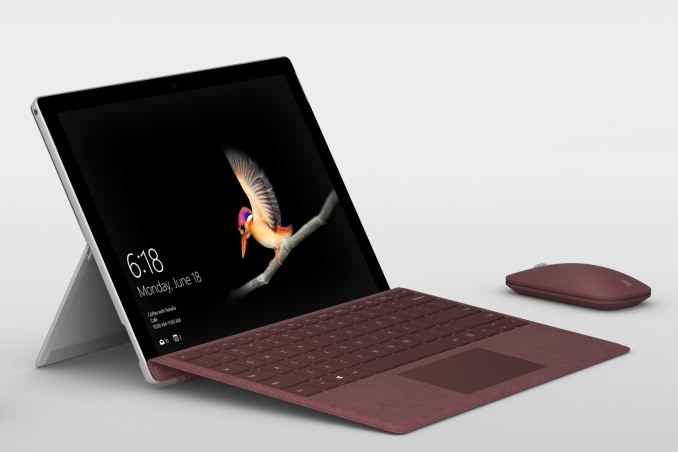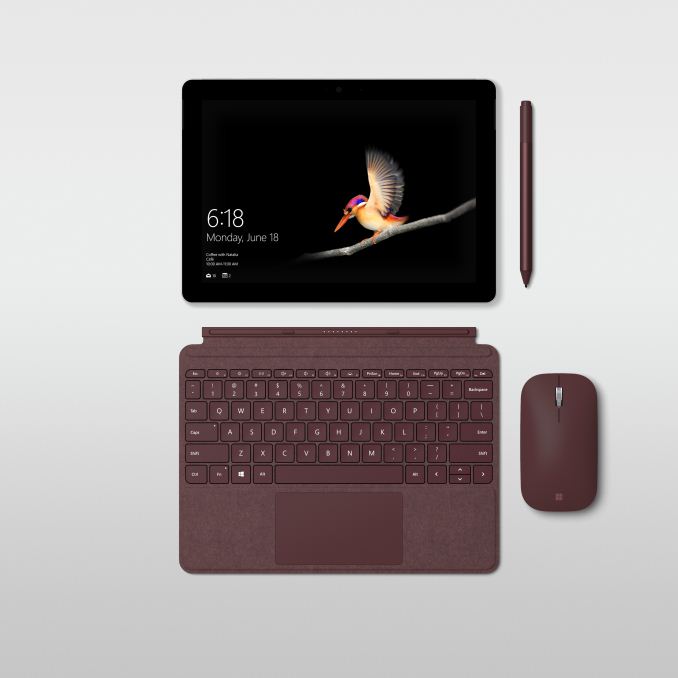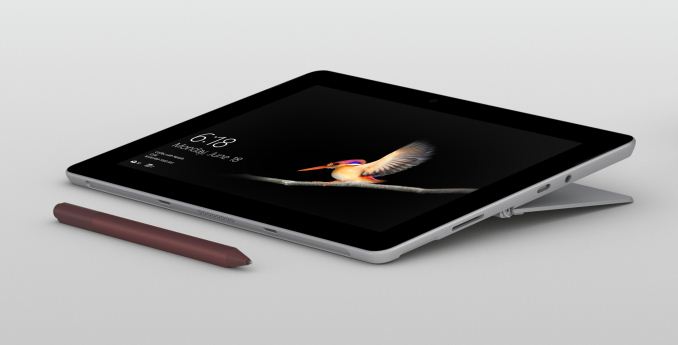Microsoft Announces The Surface Go: Smaller And Less Expensive
by Brett Howse on July 9, 2018 9:15 PM EST- Posted in
- Laptops
- Microsoft
- Surface
- Tablets
- Surface Go

Just over three years since the launch of the surprisingly good Surface 3, Microsoft has finally refreshed this category with a new device, now called the Surface Go. The Surface Pro series has been very successful for the company, and they’ve decided it’s time to offer an entry level Surface again. The Redmond company has been working on trying to win back the education market, so a smaller, lighter, and most importantly, less expensive Surface makes a lot of sense.
The Surface Go is the thinnest and lightest Surface yet at just 8.3 mm, down from the 8.7 mm of the Surface 3, and 8.5 mm on the latest Surface Pro, but it undercuts the other models on weight significantly at 521 grams, or 1.15 lbs. That’s a full 31% lighter than the larger Surface Pro.
The display is also smaller, this time coming in at 10-inches in the now familiar 3:2 aspect ratio Microsoft has focused on, and the taller aspect ratio certainly helps on mobile devices such as this that may be used in portrait. It’s an 1800x1200 PixelSense display, with 10-point multi-touch and Surface Pen support. The screen has a reasonable 216 pixels per inch of density, which is pretty much the same as the Surface 3 back in 2015 which was 213 PPI. That’s not quite as high as the Surface Pro or iPad Pro, but should still be fairly clear.
One of the biggest upgrades over the outgoing Surface 3, which was the first of the value-oriented Surface models to ship with an x86 processor, is the move from the quad-core Atom to an Intel Pentium Gold 4415Y. This is a dual-core Kaby Lake processor with four threads, and a 1.6 GHz base frequency. With a TDP of just 6W, it’s not going to be a powerhouse, but it’ll still offer solid performance for a device of this size. The low TDP also means that it can be fanless, which it is. The CPU is coupled with the Intel HD Graphics 615, which offers 24 Execution Units (EUs), although at just 850 MHz maximum boost. Still, that should offer a good jump over the Atom in the previous model.
The base model comes with just 4 GB of LPDDR3-1866, and 64 GB of eMMC storage, although it will be offered in 8 GB RAM versions with 128 GB and 256 GB NVMe SSDs, which should offer much better performance.
| Microsoft Surface Go | |||||
| Surface Go Specifications | |||||
| CPU | Intel Pentium Gold 4415Y (Kaby Lake-Y) 2 core, 4 thread, 1.6 GHz base frequency |
||||
| GPU | Intel HD 615 24 EUs 850 MHz boost frequency |
||||
| Display | 10-inch PixelSense 1800x1200 3:2 aspect 216 Pixels Per Inch 10-point Multitouch Surface Pen support |
||||
| Dimensions | 245 x 175 x 8.3 mm 9.6 x 6.9 x 0.33 inches |
||||
| RAM | 4 or 8 GB LPDDR3-1866 | ||||
| Storage | 64 GB eMMC 128 / 256 GB NVMe SSD optional |
||||
| Wireless | 802.11ac with Bluetooth 4.1 Qualcomm Snapdragon X16 LTE Optional |
||||
| Battery | Up to 9 hours of video playback 24W Charger |
||||
| Cameras | Windows Hello IR camera 5 MP Front Camera with 1080p video 8 MP Rear Camera with 1080p video |
||||
| Ports | USB Type-C 3.1 Gen 1 with power delivery Surface Connect MicroSD Headset |
||||
| Price | 4GB/64GB $399 8GB/128GB $549 Windows 10 Pro $50 extra |
||||
The Surface 3 was charged with micro USB, but the Surface Go steps up to the 24-Watt magnetic Surface Connect found on the rest of the mobile Surface lineup, and it also includes a USB 3.1 Gen 1 with a Type C connector, and they’ve kept the expandable storage with MicroSD included.
Microsoft has also included an IR camera for Windows Hello login, along with a 5 MP front camera for 1080p video, and an 8 MP rear camera. For those that want to use it on the go (pun intended) there will be an LTE model available too, which makes sense with Microsoft’s push towards Always Connected PCs.
Microsoft is claiming up to 9 hours of battery life which they tested doing video playback on the top end model.
Microsoft is also launching a new Surface Type Cover for the smaller model, featuring the same Alcantara as its larger siblings, or as just black if you prefer that. Microsoft has also found a way to fit their full-friction hinge to the smaller Surface Go, allowing for up to 165° of movement.
The new low-end Surface Go looks like a great replacement for the Surface 3, offering a way into the Surface lineup at a much more affordable price. The move to Kaby Lake will be a major boon to performance as well. Prices start at $399 for the base model, $449 for the same model with Windows 10 Pro, or $549 for 8 GB of RAM and 128 GB SSD. The 256 GB and LTE models will ship later. Pre-orders should be available soon.
Source: Microsoft













111 Comments
View All Comments
watzupken - Monday, July 9, 2018 - link
I feel MS created a notorious reputation of buggy premium products over the years. They created this great form factor no doubt, but I will not recommend getting a MS Surface product till they sort out their QC issue and the speed in which they rectify these serious bugs. I am keen to see how much they charge for this considering that Apple's SOC likely will outclass and outlast the Intel chip used here.Gunbuster - Tuesday, July 10, 2018 - link
My personal theory is the terrible WiFi chip they have used from the beginning. Way too many wireless, and power/sleep/standby/connected standby/resume bugs/miracast. They have had literally 20+ product development cycles to correct their mistake and use a good chip but they remain committed to Marvell.danielfranklin - Monday, July 9, 2018 - link
Very interesting product, i would have expected/wanted a CPU bump for the 8GB models though, 1.6ghz, even on Kaby is not great for web browsing.I would also like to confirm that the 8GB models actually use a SATA interface on their "SSD", no one likes eMMC...
Brett Howse - Monday, July 9, 2018 - link
They just said SSD on the 128/256 models. We're unsure yet if it's SATA or PCIe.North01 - Tuesday, July 10, 2018 - link
"up to a 256 GB NVMe SSD"https://youtu.be/hBxylZI4zl4?t=2m43s
Brett Howse - Tuesday, July 10, 2018 - link
Awesome thanks for the link!danielfranklin - Tuesday, July 10, 2018 - link
Fantastic, even beat my expectations.Certainly one advantage of not going down the "atom" route, from top the bottom the bandwidths available are a different level.
The graphics are the other really noticeable factor.
While the CPU clock will be an issue, for example what Intel/Apple managed with the latest version of their Y SOC for the 12" Macbook is a very rounded system, compared to previous generations or any SOC designed from the ground up for low power that is, Eg. Atom or ARM.
I dont care what anyone or whitepaper/benchmarks say, i havent had one of these ATOM/ARM SOCs that doesnt have that "Stuttering low bandwidth feel", coming quite obviously from graphics and IO but there is also more.
I think Microsoft learnt from their Surface 3. Disappointing though, that extra ~800mhz Turbo Boost to say 2.4ghz would have made a HUGE difference to the web experience, kind of a deal breaker for me but will be almost good enough for most.
LiverpoolFC5903 - Tuesday, July 10, 2018 - link
Still faster than anything with Goldmont cores though. Single threaded performance should be around 1800-2200 going by geekbench, which is admittedly not the best, but still provides a frame of reference.Namisecond - Tuesday, July 24, 2018 - link
Um, Goldmont+ in the N5000 does 1900-2200 single-threaded in Geekbench 4:http://browser.geekbench.com/v4/cpu/search?q=N5000
Xinn3r - Tuesday, July 10, 2018 - link
Is the CPU not even good enough for browsing?